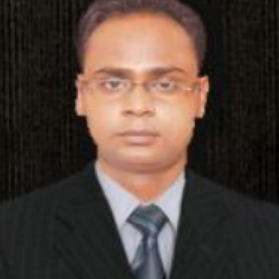
Manoj Kumar
Work place: Babasaheb Bhimrao Ambedkar University, Lucknow, India
E-mail: mkjnuiitr@gmail.com
Website:
Research Interests: Data Hiding, Image Compression
Biography
Manoj Kumar, He has received the master’s degree in computer applications from Jawaharlal Nehru University (JNU), New Delhi in 2003 and the Ph.D. in Computer Vision from Indian Institute of Technology, Roorkee, India in 2011. Currently, he is working as an Assistant Professor at the Department of Computer Science, Babasaheb Bhimrao Ambedkar University, Lucknow, India. He is the author of more than 55 research articles. His research interest includes image fusion, image compression, reversible data hiding, security, IoT, Cryptography and many more.
Author Articles
Hybrid Cryptographic Approach for Data Security Using Elliptic Curve Cryptography for IoT
DOI: https://doi.org/10.5815/ijcnis.2024.02.04, Pub. Date: 8 Apr. 2024
The Internet of Things (IoT) technology has changed the contemporary digital world. Devices connected to the IoT have sensors embedded within them. All these devices are purposely connected to share data among them through the Internet. Data sharing among IoT devices needs some security protocols to maintain the privacy and confidentiality of information. IoT devices have less computing power to perform various operations of a cryptographic process. So, there is a need of cryptographic approach to reduce the computational complexity for resource-constrained devices and provide data security. However, storing data over the cloud server also reduces storage overhead, but data transmission via the cloud is not always secure. Data integrity and authentication can be compromised because the end user can only access the data with the help of a cloud server. To ensure the security and integrity of the data, various cryptographic techniques are used. Therefore, in this paper, we propose a secure and optimized hybrid cryptographic scheme for the secure sharing of data by combining Advanced Encryption Standard (AES) and Elliptic Curve Cryptography (ECC). To ensure authentication and data integrity, the proposed scheme primarily uses the Message Authentication Code (MAC). The encrypted messages are stored on a cloud server to reduce storage overhead. The experimental findings demonstrate that the proposed scheme is effective and produces superior results as compared to existing approaches.
[...] Read more.Discrete Wavelet Transform and Cross Bilateral Filter based Image Fusion
By Sonam Manoj Kumar
DOI: https://doi.org/10.5815/ijisa.2017.01.04, Pub. Date: 8 Jan. 2017
The main objective of image fusion is to obtain an enhanced image with more relevant information by integrating complimentary information from two source images. In this paper, a novel image fusion algorithm based on discrete wavelet transform (DWT) and cross bilateral filter (CBF) is proposed. In the proposed framework, source images are decomposed into low and high frequency subbands using DWT. The low frequency subbands of the transformed images are combined using pixel averaging method. Meanwhile, the high frequency subbands of the transformed images are fused with weighted average fusion rule where, the weights are computed using CBF on both the images. Finally, to reconstruct the fused image inverse DWT is performed over the fused coefficients. The proposed method has been extensively tested on several pairs of multi-focus and multisensor images. To compare the results of proposed method with different existing methods, a variety of image fusion quality metrics are employed for the qualitative measurement. The analysis of comparison results demonstrates that the proposed method exhibits better results than many other fusion methods, qualitatively as well as quantitatively.
[...] Read more.Lossy Compression of Color Images using Lifting Scheme and Prediction Errors
DOI: https://doi.org/10.5815/ijmecs.2016.04.01, Pub. Date: 8 Apr. 2016
This paper presents an effective compression technique for lossy compression of color images. After reducing the correlation among R, G and B planes using YCoCg-R transform, the Integer Wavelet Transform (IWT) is applied on each of the transformed planes independently up to a desired level. IWT decomposes the input image into an approximation and several detail subbands. Approximation subband is compressed losslessly using prediction errors and Huffman coding, while each of the detail subbands are compressed independently using an effective quantization and Huffman coding. To show the effectiveness of proposed scheme, it is compared with several existing schemes and a state of art for image compression JPEG2000 and it is observed that the proposed scheme outperforms over the existing techniques and JPEG2000 with less degradation in the quality of reconstructed images while achieving high compression performance.
[...] Read more.A New Locally Adaptive Patch Variation Based CT Image Denoising
DOI: https://doi.org/10.5815/ijigsp.2016.01.05, Pub. Date: 8 Jan. 2016
The main aim of image denoising is to improve the visual quality in terms of edges and textures of images. In Computed Tomography (CT), images are generated with a combination of hardware, software and radiation dose. Generally, CT images are noisy due to hardware/software fault or mathematical computation error or low radiation dose. The analysis and extraction of medical relevant information from noisy CT images are challenging tasks for diagnosing problems. This paper presents a novel edge preserving image denoising technique based on wavelet transform.
The proposed scheme is divided into two phases. In first phase, input CT image is separately denoised using different patch size where denoising is performed based on thresholding and its method noise thresholding. The outcome of first phase provides more than one denoised images. In second phase, block wise variation based aggregation is performed in wavelet domain.
The final outcomes of proposed scheme are excellent in terms of noise suppression and structure preservation. The proposed scheme is compared with existing methods and it is observed that performance of proposed method is superior to existing methods in terms of visual quality, PSNR and Image Quality Index (IQI).
Other Articles
Subscribe to receive issue release notifications and newsletters from MECS Press journals